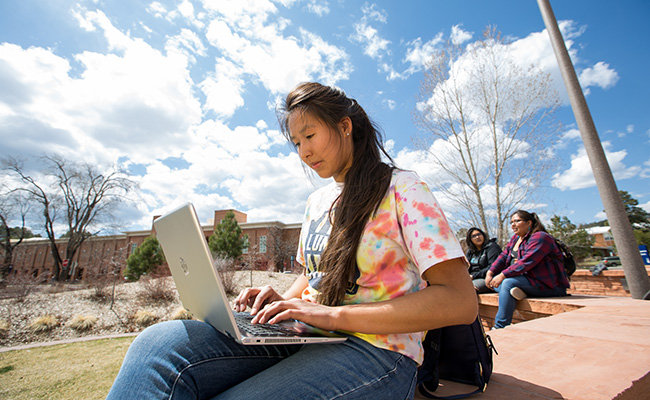A groundbreaking new program from NAU will put computers, cutting-edge scientific software and scientists in classrooms primarily serving K-12 Native American students with the goal of creating a pathway for historically underserved students into scientific computing.
Through a series of workshops in K-12 schools throughout the Southwest, students will get the opportunity to learn QIIME 2, the premier software for microbiome research, and apply the open source software to explore real-world problems. In these workshops, students will work alongside experts, including other Native American researchers.
“The ultimate goal of this project is to increase representation of Native Americans in the field of scientific computing,” said Greg Caporaso, a professor of biological sciences and QIIME 2 creator. “By working to diversify this field, we can bring different perspectives, skills and creative insights to scientific computing projects and build healthy and engaged software development communities, which enables open source developers to deliver innovative, high-quality software and educational resources that are useful to user communities with widely varying backgrounds.”
Caporaso is a principal investigator on the project, along with Jani Ingram, a Regents’ professor in chemistry, and Naomi Lee, assistant professor of chemistry at NAU, and Joslynn Lee, a chemistry professor at Fort Lewis College. It is funded by the Chan Zuckerberg Initiative.
These workshops, which join a host of other outreach programs and partnerships NAU has with Native American communities, will get students comfortable with the software and the processes involved in this work as well as introduce them to the role of computers and software in studying microbes. Amid the backdrop of a worldwide pandemic, understanding microbes has never been more important.
“In addition to being important to life on Earth and being found in the environment, microbes are also related to health and disease,” Joslynn Lee said. “Mixing the microbial communities with scientific computing skills is an engaging and relevant learning experience.”
All of this together meets an overarching goal of the collaboration: to build awareness of career opportunities in scientific computing—a field in which Native Americans have been historically underrepresented—and provide pathways for students into these careers. At the end of each workshop, the computers and associated software will stay at the schools, if needed, so students can continue gaining experience and giving future students access to these resources as well.
“The workshops will build knowledge and awareness of QIIME 2 through an Indigenous lens, including addressing issues

they may see in their communities every day,” said Naomi Lee, who is a Native American researcher. “The workshops will also expose Native youth to Native researchers who are experts in various STEM fields and help students see themselves going to college and working in these fields.”
The project also will conclude with a workshop at NAU to which students and faculty from the original workshops will be invited, as well as current NAU students who are interested in scientific computing. Not only will this event offer additional learning and networking opportunities, but it will give high school students a chance to experience university life, get excited about higher education and help them feel comfortable in the environment, thus contributing to the likelihood of success as university students.
Only .5 percent of students in a STEM program nationwide are Indigenous, while .4 percent of STEM professionals identify as Indigenous. To combat this, Naomi Lee, Ingram and Caporaso have all made recruiting and mentoring historically underserved students a priority in their work. Other departments at NAU also have a focus on Native American recruitment and outreach; the Institute of Tribal Environmental Professionals has been doing STEM outreach in tribal schools for 23 years, and the Native American Cancer Prevention program, which Ingram leads, works directly with Native populations to address health disparities.
Mansel Nelson, a program manager for ITEP, recognizes the importance of connecting Native American students with STEM projects that apply science to local concerns and issues.
“When our students see the immediate benefit of STEM projects to family and community, they are motivated to invest the time and effort to learn and apply the STEM tools,” he said.
Ingram, who also is the PI of the Partnership for Native American Cancer Prevention, agreed. It’s why programs such as this one need to exist.
“I was excited to be a part of the proposal led by Greg to expose our Native American students at an early age to the power of scientific computing,” she said. “Giving them a vision for their futures will be very impactful for them and their communities.”
To learn more about the project, request a workshop at your school or get involved in teaching scientific computing workshops, email greg.caporaso@nau.edu.



